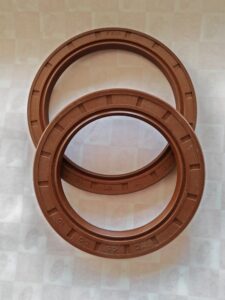Table of Contents
ToggleWhat Are the Disadvantages of FKM?
FKM (Fluorocarbon Elastomer), while renowned for its high-temperature stability and chemical resistance, carries several critical drawbacks that limit its use in certain applications. Below is a detailed analysis of its key disadvantages, supported by industry data and practical considerations.


1. High Cost and Supply Constraints
FKM is 3–4× more expensive than standard elastomers like NBR or EPDM due to its fluorine-rich chemistry and complex manufacturing processes.
- Material Costs:
- Standard FKM seals cost ~
- 5–
- 5–10 per unit, compared to ~
- 1–
- 1–3 for NBR equivalents.
- Specialty grades (e.g., low-temperature FKM) incur additional premiums.
- Supply Chain Issues:
- Feedstock shortages and production complexities lead to sporadic availability, especially for niche formulations.
2. Limited Low-Temperature Flexibility
Standard FKM grades stiffen below -20°C, risking seal failure in cold environments.
- Low-Temperature Limitations:
- Becomes brittle, losing elasticity and sealing force.
- Requires costly specialty grades (e.g., FKM-GBL-S) to extend usability to -40°C.
- Comparison:
- Silicone (VMQ) and NBR retain flexibility down to -60°C and -40°C, respectively.
3. Chemical Incompatibilities
Despite broad hydrocarbon resistance, FKM performs poorly in specific chemical environments:
| Incompatible Media | Impact | Alternatives |
| Polar Solvents (ketones, esters, amines) | Swelling (20–30%) and degradation. | FFKM (costly) or EPDM. |
| Glycol-Based Fluids (brake fluids, water-glycol hydraulics) | Seal failure due to incompatibility. | EPDM or HNBR. |
| Steam/Hot Water | Rapid aging and loss of mechanical properties. | Silicone or EPDM. |
4. Processing Challenges
FKM’s manufacturing demands are more complex than standard elastomers:
- Curing Requirements:
- Requires high temperatures (170–200°C) and extended cure cycles (3–4× slower than NBR).
- Post-curing often needed to optimize mechanical properties.
- Safety Concerns:
- Releases toxic vapors during vulcanization, necessitating strict ventilation controls.
5. Compression Set and Cold Flow
While FKM generally outperforms many elastomers, some grades exhibit limitations:
- Compression Set:
- ~20% compression set after prolonged static loading at high temperatures.
- Leads to gradual loss of sealing force in static applications.
- Cold Flow:
- Limited polymer chain mobility in dynamic applications causes material migration, compromising seal integrity.
6. Mechanical Limitations
- Abrasion Resistance: Inferior to polyurethane or HNBR in high-wear environments.
- Tear Strength: Lower than natural rubber or silicone.
- Gas Permeability: Very low permeability hinders pressure equalization in pneumatic systems.
7. Regulatory and Application Constraints
- FDA Compliance:
- Non-FDA grades are unsuitable for food, beverage, or pharmaceutical applications.
- Requires platinum-cured silicone or FFKM for hygienic uses.
- Dynamic Performance:
- Less suitable for high-speed, high-friction applications compared to polyurethane.
When to Avoid FKM?
- Low-Temperature Environments (<-20°C) without specialty grades.
- Exposure to Polar Solvents (ketones, glycols, amines).
- High-Wear Applications requiring superior abrasion resistance.
- Budget-Sensitive Projects where NBR/EPDM suffice.
Alternatives to FKM
| Scenario | Better Choice | Reason |
| Extreme cold sealing | Silicone (VMQ) | Flexible down to -60°C. |
| Glycol/steam resistance | EPDM | Excellent polar fluid compatibility. |
| Cost-sensitive applications | NBR | Affordable for moderate temperatures/oils. |
| Aggressive chemical exposure | FFKM | Resists nearly all chemicals (higher cost). |
Industry-Specific Drawbacks
Aerospace & Automotive
- Supply Delays: Specialty FKM grades face lead times due to supply-chain bottlenecks.
- Weight Sensitivity: Higher density than silicone or EPDM adds marginal weight penalties.
Industrial & Chemical Processing
- Steam Sterilization: Unsuitable for autoclave or steam-cleaning systems.
- Rapid Gas Venting: Low permeability hinders pressure equalization in pneumatic actuators.
Conclusion
While FKM excels in high-temperature, oil-rich environments, its high cost, low-temperature brittleness, chemical incompatibilities, and processing challenges are significant limitations. Engineers must carefully evaluate operational requirements and consider alternatives like EPDM, silicone, or FFKM for niche applications. For non-polar, high-heat scenarios, however, FKM remains a reliable choice.



Leave A Comment